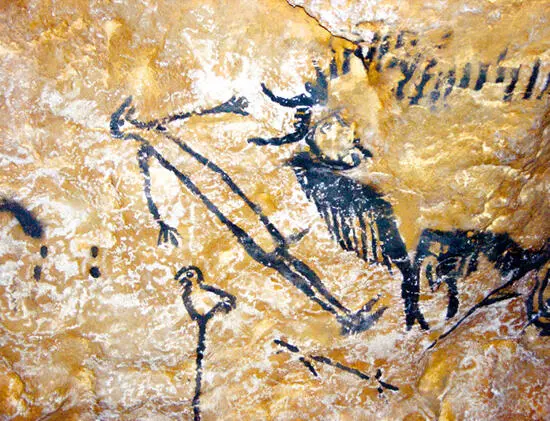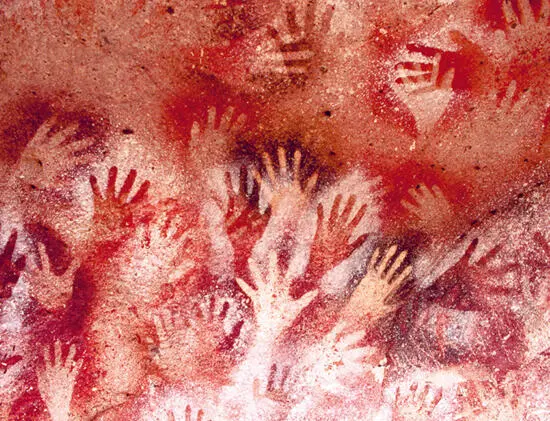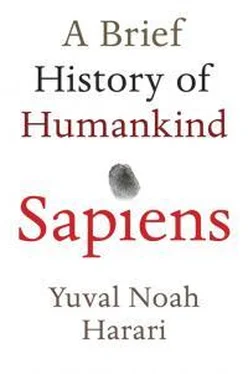The sociopolitical world of the foragers is another area about which we know next to nothing. As explained above, scholars cannot even agree on the basics, such as the existence of private property, nuclear families and monogamous relationships. It’s likely that different bands had different structures. Some may have been as hierarchical, tense and violent as the nastiest chimpanzee group, while others were as laid-back, peaceful and lascivious as a bunch of bonobos.

8. A painting from Lascaux Cave, c .15,000–20,000 years ago. What exactly do we see, and what is the painting’s meaning? Some argue that we see a man with the head of a bird and an erect penis, being killed by a bison. Beneath the man is another bird which might symbolise the soul, released from the body at the moment of death. If so, the picture depicts not a prosaic hunting accident, but rather the passage from this world to the next. But we have no way of knowing whether any of these speculations are true. It’s a Rorschach test that reveals much about the preconceptions of modern scholars, and little about the beliefs of ancient foragers.
In Sungir, Russia, archaeologists discovered in 1955 a 30,000-year-old burial site belonging to a mammoth-hunting culture. In one grave they found the skeleton of a fifty-year-old man, covered with strings of mammoth ivory beads, containing about 3,000 beads in total. On the dead man’s head was a hat decorated with fox teeth, and on his wrists twenty-five ivory bracelets. Other graves from the same site contained far fewer goods. Scholars deduced that the Sungir mammoth-hunters lived in a hierarchical society, and that the dead man was perhaps the leader of a band or of an entire tribe comprising several bands. It is unlikely that a few dozen members of a single band could have produced so many grave goods by themselves.

9. Hunter-gatherers made these handprints about 9,000 years ago in the ‘Hands Cave’, in Argentina. It looks as if these long-dead hands are reaching towards us from within the rock. This is one of the most moving relics of the ancient forager world – but nobody knows what it means.
Archaeologists then discovered an even more interesting tomb. It contained two skeletons, buried head to head. One belonged to a boy aged about twelve or thirteen, and the other to a girl of about nine or ten. The boy was covered with 5,000 ivory beads. He wore a fox-tooth hat and a belt with 250 fox teeth (at least sixty foxes had to have their teeth pulled to get that many). The girl was adorned with 5,250 ivory beads. Both children were surrounded by statuettes and various ivory objects. A skilled craftsman (or craftswoman) probably needed about forty-five minutes to prepare a single ivory bead. In other words, fashioning the 10,000 ivory beads that covered the two children, not to mention the other objects, required some 7,500 hours of delicate work, well over three years of labour by an experienced artisan!
It is highly unlikely that at such a young age the Sungir children had proved themselves as leaders or mammoth-hunters. Only cultural beliefs can explain why they received such an extravagant burial. One theory is that they owed their rank to their parents. Perhaps they were the children of the leader, in a culture that believed in either family charisma or strict rules of succession. According to a second theory, the children had been identified at birth as the incarnations of some long-dead spirits. A third theory argues that the children’s burial reflects the way they died rather than their status in life. They were ritually sacrificed – perhaps as part of the burial rites of the leader – and then entombed with pomp and circumstance. 9
Whatever the correct answer, the Sungir children are among the best pieces of evidence that 30,000 years ago Sapiens could invent sociopolitical codes that went far beyond the dictates of our DNA and the behaviour patterns of other human and animal species.
Peace or War?
Finally, there’s the thorny question of the role of war in forager societies. Some scholars imagine ancient hunter-gatherer societies as peaceful paradises, and argue that war and violence began only with the Agricultural Revolution, when people started to accumulate private property. Other scholars maintain that the world of the ancient foragers was exceptionally cruel and violent. Both schools of thought are castles in the air, connected to the ground by the thin strings of meagre archaeological remains and anthropological observations of present-day foragers.
The anthropological evidence is intriguing but very problematic. Foragers today live mainly in isolated and inhospitable areas such as the Arctic or the Kalahari, where population density is very low and opportunities to fight other people are limited. Moreover, in recent generations, foragers have been increasingly subject to the authority of modern states, which prevent the eruption of large-scale conflicts. European scholars have had only two opportunities to observe large and relatively dense populations of independent foragers: in north-western North America in the nineteenth century, and in northern Australia during the nineteenth and early twentieth centuries. Both Amerindian and Aboriginal Australian cultures witnessed frequent armed conflicts. It is debatable, however, whether this represents a ‘timeless’ condition or the impact of European imperialism.
The archaeological findings are both scarce and opaque. What telltale clues might remain of any war that took place tens of thousands of years ago? There were no fortifications and walls back then, no artillery shells or even swords and shields. An ancient spear point might have been used in war, but it could have been used in a hunt as well. Fossilised human bones are no less hard to interpret. A fracture might indicate a war wound or an accident. Nor is the absence of fractures and cuts on an ancient skeleton conclusive proof that the person to whom the skeleton belonged did not die a violent death. Death can be caused by trauma to soft tissues that leaves no marks on bone. Even more importantly, during pre-industrial warfare more than 90 per cent of war dead were killed by starvation, cold and disease rather than by weapons. Imagine that 30,000 years ago one tribe defeated its neighbour and expelled it from coveted foraging grounds. In the decisive battle, ten members of the defeated tribe were killed. In the following year, another hundred members of the losing tribe died from starvation, cold and disease. Archaeologists who come across these no skeletons may too easily conclude that most fell victim to some natural disaster. How would we be able to tell that they were all victims of a merciless war?
Duly warned, we can now turn to the archaeological findings. In Portugal, a survey was made of 400 skeletons from the period immediately predating the Agricultural Revolution. Only two skeletons showed clear marks of violence. A similar survey of 400 skeletons from the same period in Israel discovered a single crack in a single skull that could be attributed to human violence. A third survey of 400 skeletons from various pre-agricultural sites in the Danube Valley found evidence of violence on eighteen skeletons. Eighteen out of 400 may not sound like a lot, but it’s actually a very high percentage. If all eighteen indeed died violently, it means that about 4.5 per cent of deaths in the ancient Danube Valley were caused by human violence. Today, the global average is only 1.5 per cent, taking war and crime together. During the twentieth century, only 5 per cent of human deaths resulted from human violence – and this in a century that saw the bloodiest wars and most massive genocides in history. If this revelation is typical, the ancient Danube Valley was as violent as the twentieth century. *
Читать дальше





![Юваль Ной Харари - Sapiens. Краткая история человечества [litres]](/books/34310/yuval-noj-harari-sapiens-kratkaya-istoriya-cheloveche-thumb.webp)





![Юваль Ной Харари - 21 урок для XXI века [Версия с комментированными отличиями перевода]](/books/412481/yuval-noj-harari-21-urok-dlya-xxi-veka-versiya-s-ko-thumb.webp)


